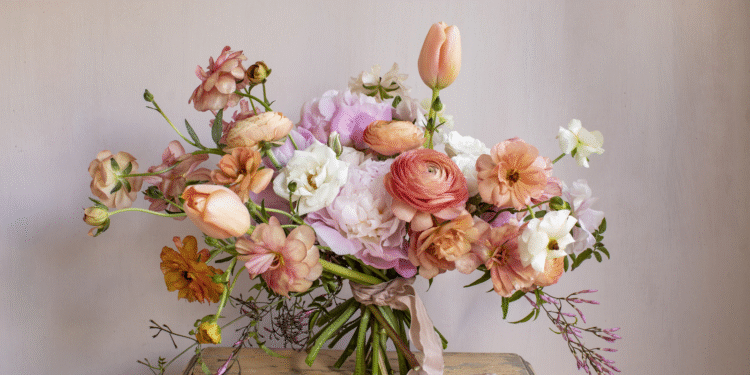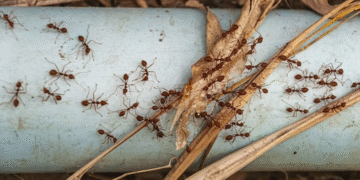Many people struggle to make a bouquet that looks full and balanced. A great bouquet mixes greens, focal flowers, and fillers in the right way. This guide will share simple tips from expert florists to help you design better bouquets at home.
Keep reading for secrets that can change your flower game today!
Key Elements of a Perfect Bouquet
A great bouquet needs different types of flowers and greens. Each part plays an important role in making it look beautiful and balanced.
Greens and Foliage
Greens and foliage give structure to bouquet design. They fill gaps between fresh blooms and help support the flowers. Florists use different types of greenery like eucalyptus, ruscus, or ferns for texture and height.
Greenery adds depth to every floral arrangement. Use about 30% greenery in your creation for balance.
Greenery brings a calm background that lets each flower shine.
Foliage also makes cut flowers last longer by keeping stems steady in the vase. The contrast of green leaves with bright petals creates harmony and helps each accent stand out. Mix wide leaves with thin sprigs to add movement in your bouquet.
Focal Flowers
Focal flowers grab attention in any bouquet. Big blooms like roses, lilies, or sunflowers work well as the center of your floral arrangement. Florists often use fresh blooms at their peak for this purpose.
These main flowers set the style and mood of your bouquet design.
Use two to five focal flowers for most medium bouquets. This number gives structure without crowding your arrangement. Choose vibrant colors that match or contrast with your accents and fillers so you create harmony in every bouquet.
Accent and Filler Flowers
After picking the main blooms, add accent and filler flowers to complete your bouquet. Accent flowers draw attention with their shape or color but do not take over the design. Good examples are waxflower, statice, or mini carnations.
Filler flowers, like baby’s breath and solidago, fill empty spaces between larger blooms. These small blossoms help tie together different colors and make fresh bouquets look full.
Use fillers to create harmony in your floral arrangement and support the structure of your bouquet design.
The 60-30-10 Rule for Floral Arrangements
The 60-30-10 rule helps create balanced floral arrangements. Use this guideline to mix different elements in your bouquet design. The main part, or focal flowers, should take up 60% of the arrangement.
Choose bold blooms to draw attention.
Next, use accent and filler flowers for 30% of the space. These smaller flowers add depth and fill empty spots around the focal flowers. Finally, greenery makes up the last 10%. This foliage adds structure and softness to complete your look.
A good flower arrangement is like a painting; it needs balance, color, and harmony.
Choosing the Right Color Palette
Choosing colors makes a big difference in bouquet design. Start with your main color, or focal flower. This sets the tone for the entire arrangement. Next, pick two or three accent colors that complement it well.
These should be lighter or darker shades of the main color.
Think about seasonal flowers too. Bright blooms work great for summer bouquets while soft pastels fit spring better. Don’t forget to add greenery as it balances out bold colors and adds depth to your arrangement.
A strong color palette creates harmony and helps each flower shine in its own way—turning your arrangement into a universal gift that suits many styles and occasions.
Creating Depth and Texture
Depth and texture add interest to a bouquet. Use different flower shapes and sizes to create layers. Tall flowers can rise above shorter ones, giving your arrangement height. Mix smooth petals with rough or spiky textures for contrast.
Adding greenery helps create depth as well. Leaves can fill in gaps while also creating a frame around blooms. Vary the types of foliage you use; some can drape while others stand tall.
This mixture makes the bouquet more inviting and lively to look at. Adding filler flowers also enhances this aspect, making your design richer and fuller without overwhelming it.
Cutting Flowers to the Right Height
Cutting flowers to the right height is key for a lovely bouquet. The correct height creates balance and makes your arrangement pop.
- Assess the vase before cutting. Consider its height and shape. This helps you decide how long to cut your flowers.
- Cut stems at an angle. An angled cut allows better water uptake, keeping blooms fresh longer.
- Start with focal flowers first. These are usually the largest or most eye-catching blooms in your bouquet.
- Follow with accent flowers next. They add color and interest but should be slightly shorter than focal flowers.
- Use fillers last in your arrangement. Fillers often need to be the shortest to create a full look without overwhelming the focal points.
- Always remove excess leaves before cutting stems too short; this keeps your bouquet cleaner and more appealing.
- Make sure all cut stems are even; uneven heights can make a bouquet look messy or unplanned.
- Check for balance as you go along; adjust heights if needed to achieve harmony within the design.
- Trim stems again just before placing them in water; this ensures maximum hydration right from the start.
Cutting flowers well enhances your floral composition and brings out their beauty in every arrangement, helping you create the best flower bouquet.
Tips for Arranging Bouquets Like a Pro
When arranging bouquets, use layers for balance. Group flowers in odd numbers for a more natural look. This technique will make your design stand out. Want to learn more?
Layering for Balance
Layering is key to a balanced bouquet. A well-structured floral arrangement catches the eye and feels harmonious.
- Start with a strong base of greenery. Use leaves and stems to create support for your flowers. This adds depth and stability.
- Place focal flowers next. These are the main blooms that draw attention. Choose larger and vibrant flowers for this step.
- Add accent flowers after the focal ones. These blooms give extra color and detail to the arrangement. They should complement but not overshadow the focal flowers.
- Incorporate filler flowers last. These smaller blooms fill in gaps within the bouquet, adding softness and texture. Choose delicate varieties to keep it light.
- Layer heights for interest. Use both tall and short stems to create visual appeal. This adds dimension to your design.
- Balance colors throughout the arrangement. Distribute bold colors evenly among softer tones for harmony in design.
- Keep odd-numbered groupings in mind when layering flowers together, as they create a more natural look and feel.
- Rotate the bouquet as you work on it; inspect all sides for balance. Adjust placement or heights as needed to achieve an even appearance.
- Step back often to view your progress from afar, ensuring visual balance throughout the entire bouquet design.
- Trust your instincts; if something feels off, don’t hesitate to make changes until everything feels right in relation to floral arrangement details and structure.
Choosing layers wisely creates a stunning final product that reflects care in its crafting techniques while showcasing harmony among fresh blooms.
Using Odd Number Groupings
Layering adds balance to a bouquet. Odd number groupings help create visual interest. Use three, five, or seven flowers for your focal points. This method draws the eye and makes arrangements pop.
Odd numbers keep things dynamic. They avoid symmetry, which can feel too structured. Each flower stands out better when grouped this way. Using odd number groupings enhances harmony in your floral design while bringing freshness to each arrangement.
Preparing Your Vase for the Arrangement
A clean vase is key for your bouquet. It helps flowers stay fresh longer.
- Start with a clean vase. Wash it with warm water and soap to remove dirt and germs.
- Rinse the vase well. Any soap left can harm the flowers.
- Fill the vase with fresh, clean water. Use water that is room temperature for best results.
- Add flower food to the water if you have it. Flower food gives extra nutrients to help blooms last longer.
- Trim the ends of the stems at an angle before placing them in water. This helps flowers drink more water.
- Remove any leaves that touch the water; these can rot and cause bacteria growth.
- Place the vase in a cool area, away from direct sunlight or heat sources like radiators.
- Regularly change the water every few days to keep it clear and fresh.
Next, caring for your bouquet will help it thrive longer and look beautiful each day.
Caring for Your Bouquet to Prolong Freshness
Caring for your bouquet helps keep it fresh and beautiful. Follow these tips to extend its life.
- Fill your vase with clean, cool water. Change the water every few days to prevent bacteria growth.
- Trim the stems at an angle before placing them in the vase. This allows better water absorption.
- Remove any leaves that touch the water. This helps keep the water clear and fresh.
- Keep your bouquet away from direct sunlight and heat sources. Flowers last longer in cooler conditions.
- Add flower food to the water if provided with a packet. This supplies nutrients and helps maintain freshness.
- Mist the petals lightly with water daily. This adds humidity and keeps blooms looking fresh.
- Avoid placing flowers near fruits or vegetables; they release gases that can speed up wilting.
- Check for wilted or dying flowers regularly and remove them promptly; this helps maintain bouquet health.
- Use a clean vase each time you arrange flowers; bacteria thrive in dirty vases, harming your blossoms.
Proper care ensures your floral arrangement stays vibrant, leading to mistakes to avoid when creating bouquets next.
Common Mistakes to Avoid When Making Bouquets
After ensuring your bouquet stays fresh, it’s time to focus on common mistakes. Avoiding these errors can lead to a better floral arrangement.
- Skipping Greeneries. Greens add depth and fill gaps. They can make your bouquet look fuller and more balanced.
- Ignoring Flower Height. Flowers should be varied in height to create interest. Long stems can overshadow shorter ones if not placed properly.
- Choosing Wrong Color Combinations. Colors should match or complement each other for harmony. Clashing colors can make your bouquet less appealing.
- Using Too Many Different Flowers. Too many types of flowers can confuse the eye. Stick to a few focal and accent flowers for better impact.
- Forgetting About Seasonality. Seasonal blooms are fresher and often last longer than out-of-season choices. Adjust your designs based on what is available.
- Overloading with Filler Flowers. Fillers serve a purpose, but too much can overwhelm the main flowers. Use them sparingly to enhance the design without cluttering it.
- Not Cutting Stems Properly. Always cut stems at an angle before placing them in water; this allows better water absorption and extends flower life.
- Neglecting Water Quality in Vases. Dirty water contains bacteria that harm flowers quickly; clean vases help maintain freshness longer.
- Placing Blooms Without Careful Consideration of Structure.
Flowers need a solid structure for support; weak arrangements fall apart easily during transport or display. - Ignoring Bouquet Proportions and Balance.
Bouquets should feel balanced, not top-heavy or lopsided; pay attention to grouping and layering for even distribution throughout the arrangement.
Pro Tools Every Florist Swears By
Every florist has their favorite tools. These tools help create stunning bouquets.
- Sharp scissors or clippers are essential. They make clean cuts on stems. Clean cuts help flowers drink water better.
- A floral knife is useful for trimming stems quickly. It provides precision when cutting tough woods.
- Wire cutters come in handy for shaping arrangements. They cut through floral wire easily.
- Floral foam holds flowers in place. It helps keep them fresh and hydrated.
- A sturdy vase is important for support. Vases come in many shapes and sizes.
- Flower food keeps blooms fresh longer. It provides nutrients that cut flowers need.
- Tape or grid can secure flower positions in the vase. This technique creates stable arrangements.
- Tweezers allow for precise placement of small blooms or accents.
- A spray bottle helps mist flowers to keep them hydrated and looking vibrant.
- Gloves protect hands while working with thorny stems or messy materials, ensuring comfort during arrangement.
These tools elevate any floral arrangement to the next level, allowing florists to craft beautiful bouquets with ease while ensuring harmony and structure in each design process with greens and fillers included as well as focal flowers for a complete look.
Conclusion
Creating the perfect bouquet is fun and rewarding. Use these tips to bring your floral vision to life. Focus on balance, color, and care for freshness. With practice, you will craft beautiful arrangements like a pro.













